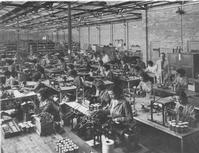


Chapter 8
I Part 1: Communications
i Before the Telegraph
ii Electrical Communication Before Federation
iii Federation to the End of the Second World War
iv Post-war and on to 1975
v 1975 ONWARDS
II Epilogue
III Part 2: Early Australian Computers And Computing
IV Acknowledgements
References
Index
Search
Help
Contact us

Post-war and on to 1975
In the post-war years Australia was faced with communication systems which had been strained by the demands of the war years, the inherent problems of large step by step networks, a shortage of skills at all levels, a world shortage of communications equipment, a rapid rise in demand for services as the economy and population both grew strongly and an increasing rate of change in technology.The availability of professional staff improved quite rapidly as a number of engineering faculties at universities established communication departments with, in due course, post-graduate facilities. At the technical level the APO, as the PMG Department was becoming known, developed its training facilities and later in the period a wide range of certificate courses became available from technical schools.
Fundamental changes took place in equipment supply as the APO developed a policy of buying from Australian manufacturers leading, after extensive negotiations, to the establishment by STC and TEI of factories for the production of switching equipment, joined later by L. M. Ericsson when that company's crossbar system was selected as the Australian standard. Arrangements were entered into also for the Australian manufacture of transmission equipment, telephones, PABXs, switchboards and a range of other items, largely by Australian subsidiaries of multi-national communication companies. A second major cable manufacturer, Olympic, later known as Olex, also established manufacturing facilities in line with the APO's policy of at least two suppliers of major items. From industry's viewpoint, the system had the feature that there was only one important buyer of their output. The technology was essentially transferred from the parent companies but designs increasingly incorporated features required by Australia and, for various items, interfacing facilities with the Australian network were developed. The extent to which this was done locally varied, but STC and later LME built up considerable design and development capacity which gave also a capacity for items to be designed and developed in Australia, while AWA combined their own skills with various licence agreements and a range of other companies developed local expertise in particular fields.

Milestones along the path of Australian manufacture were 600 Type relays in 1946, a start on automatic switching equipment in 1947, with full manufacture achieved in 1954, SE50 switches in 1957, commencement of crossbar equipment in 1961, STC produced a locally designed crossbar PABX in 1962 and followed this in 1975 with a locally designed electronic PABX range. On the transmission side, 3 channel carrier equipment was produced in 1945, 12 channel equipment in 1952, with a locally developed transistorised version ten years later, while production of cable carrier equipment ranged from 12 channel systems in 1948 to 12 mHz coaxial line equipment in 1974. By the end of the period some 90 per cent of equipment purchased by the APO was manufactured in Australia, although a sudden reduction in the level of protection for components led to a contraction in the relatively small component industry, resulting in turn in a fall in Australian added value, particularly as the role of electronics in communication technology continued to grow rapidly. For its part, the APO evolved a substantial ability in system and network design, system specification, tender evaluation and prototype testing, integration of new designs into the established network, as well as expertise in system operation and maintenance.
Organisations in Australian Science at Work - Amalagamated Wireless Australia (A.W.A.); Australian Post Office (A.P.O.); L. M. Ericsson; Standard Telephones and Cables (S.T.C.); Telephone & Electrical Industries (T.E.I.)
 |
Australian Academy of Technological Sciences and Engineering |  |
© 1988 Print Edition pages 559 - 560, Online Edition 2000
Published by Australian Science and Technology Heritage Centre, using the Web Academic Resource Publisher
http://www.austehc.unimelb.edu.au/tia/545.html